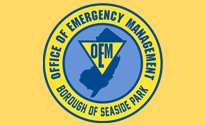Emergency Services
Tri-Boro First Aid Squad, Inc.
| Location: Tri-Boro First Aid Squad, Inc. J Street Seaside Park, NJ 08752 |
Contact (non-emergencies): |
For Emergencies Dial: 911
Official Website: http://www.tri-borofirstaid.com/
Donation Information
History

The Tri-Boro First Aid Squad was founded in January 1938. During the first year of operation, the Squad rendered assistance in 83 emergency calls and 68 silent transportation calls, traveling a total distance of 6,000 miles. The first Squad Building, located on J Street, was completed in 1939. The first ambulance was a ten-year-old Studebaker purchased from the Point Pleasant First Aid Squad. It was first housed in Flitcroft’s garage before the J Street building was constructed, with volunteers answering first aid calls in the three towns originally covered by the Squad: Seaside Park, Seaside Heights and Lavallette. Lavallette soon organized its own first aid squad, and Tri-Boro added the Borough of Island Beach to its coverage area. The first patient of the Tri-Boro First Aid Squad was C. Vernon Sparks, who had suffered a heart attack. The ambulance was in Point Pleasant to be painted, yet responded to the call for assistance at record speeds. The Squad assisted Dr. Samuel Tilles in saving Sparks life. In 1940, two more ambulances were acquired, a LaSalle and a second hand Buick. The LaSalle was advertised as “one of the finest in New Jersey, the body custom built, equipped to carry four persons … with running water and the cot equipped with an airflow mattress.” Another Buick was purchased in 1948 and a Cadillac was bought in 1953. Membership in the Tri-Boro First Aid Squad decreased during World War II, when only seven of the 21 members were on hand to serve the three communities. Today, the Squad has more than sixty members. Construction on a new Squad Building began in March 1971 and was dedicated Saturday, December 16, 1972. The Squad continues to update their equipment and replace older vehicles.
Residents of the borough who volunteer their time as members of the Tri-Boro First Aid Squad are notified of an emergency by a pager and by a siren. Please be alert for members responding to the first aid squad building at J Street; yield to personal vehicles with blue lights or hazard lights flashing.
As a volunteer organization, the squad relies heavily on residents for support. To join the first aid squad, first aid squad auxiliary, or to make a financial donation, please contact the first aid squad. The Tri-Boro First Aid Squad provides emergency services to Seaside Park, the South Seaside Park section of Berkeley Township, and Seaside Heights.
General First Aid For Common Ailments For Informational Purposes Only
First Aid for Sunburn
Sunburns can be very serious. Ranging from mild discomfort to severe burning over a large portion of the body, a bad sunburn can also be further complicated by heatstroke. For minor sunburn, give first aid as follows:
- Check the person thoroughly to determine the extent and severity of the burn.
Get out of the sun immediately. - Cover the burn with a wet towel or gently sponge the area with cool water to relieve pain.
- Pat the skin dry and apply medicated sunburn ointment or lotion. Apply according to directions on the package and watch for warning signs of an allergic reaction.
- Protect burnt areas from further exposure to the sun.
- Don’t break any blisters–doing so may promote infection. If large areas of the skin begin to blister, seek medical help.
- If the person begins to vomit or develops a fever, give first aid for heatstroke and get medical help.
Heatstroke
- A life-threatening condition where the body’s temperature rises far above normal. The body’s temperature control mechanism fails, sweating may stop and the body temperature rises rapidly. When you notice rapid pulse, noisy breathing, convulsions or vomiting and hot, flushed skin, give first aid for heatstroke.
- Check for symptoms of heatstroke. Lowering the body temperature is the most urgent first aid for heatstroke.
- Move the person to a cool, shaded place or indoors if possible. Call for medical help.
- Cool the person by removing clothing, covering with a wet sheet, immersing in cool water or sponging with cool water, especially in the armpits, neck and groin areas.
- When the body feels cool to the touch, cover the casualty with a dry sheet. Put the conscious casualty into the shock position and the unconscious casualty into the recovery position. If temperature begins to rise again, repeat step three.
- Continue to monitor the person until medical help is available.
Insect bite or sting
- Examine the sting site closely, looking for the stinger that may be still in the skin.
- If a stinger is visible and accessible, attempt to remove it by carefully scraping it and the attached poison sac from the skin. Don’t use tweezers, fingers or anything that might squeeze more poison into the body.
- To reduce the irritation at the site of the sting, apply rubbing alcohol, a weak ammonia solution or a paste of baking soda and water. Ice can also be used. Never use alcohol or ammonia near the eyes.
- If the sting is in the mouth, give the person a mouthwash of one teaspoonful of baking soda in a glass of water, or a piece of ice to suck on. Monitor the person for swelling or difficulty breathing. If symptoms occur, get medical help.
Signs of an allergic reaction to insect bite or sting
- General itching, rash developing at site and over body.
- A bump on the skin may form, that may be white, pink, reddish or blotchy.
- The person may experience generalized swelling, especially of the airway.
- Weakness and headache.
- Fever.
- Breathing difficulties may be become severe – if this happens get medical help immediately.
- The person may express anxiety.
- Abdominal cramps and vomiting.
Area Hospitals
Community Medical Center![]() 99 Highway 37 West
99 Highway 37 West
Toms River, New Jersey 08755
732-557-8000
Ocean Medical Center![]()
425 Jack Martin Blvd
Brick, NJ 08724
732-840-2200
Kimball Medical Center![]()
600 River Avenue
Lakewood, NJ 08701
732-363-1900
Jersey Shore Medical Center![]()
1945 Rte 33
Neptune, NJ 07753
732-775-5500























